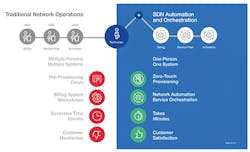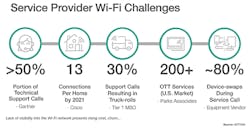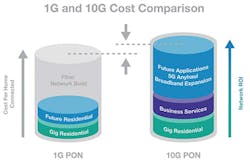Technology Strategies for Municipal Fiber Broadband
The Model that Serves Residential, Enterprise, and Municipal Needs —
In an effort to improve their cities’ market competitiveness on the national and global stage, municipalities are looking to bolster their broadband service delivery capabilities. As they look to build out best-of-breed broadband networks that will support residential broadband applications as well as critical enterprise and municipal initiatives, they will need to make a significant decision regarding the network technology selection.
Municipal network planners and operators need to make the right investment decisions from a cost standpoint while identifying solutions that can best future-proof their networks to meet the demands of their communities and subscribers for many years to come. Two critical lessons for today’s municipal broadband network builders concern the value of investing in a modern, high-capacity gigabit service architecture while providing the best subscriber experience.
Choosing the Right Broadband Delivery Solution
Even though there is no one-size-fits-all approach to broadband deployment, fiber optic solutions are universally viewed as the best path forward for municipal network development, and when comparing fiber broadband technologies, Passive Optical Networks (PON) has become the most cost-effective, the most scalable technology, for delivering broadband services.
InvisiLight® Solution for Deploying Fiber
April 2, 2022Go to Market Faster. Speed up Network Deployment
April 2, 2022Episode 10: Fiber Optic Closure Specs Explained…
April 1, 2022Food for Thought from Our 2022 ICT Visionaries
April 1, 2022PON technologies have become the de facto fiber broadband delivery method. This is due to the lower cost per connection, lower carbon footprint, and greatly reduced real estate requirements, compared to point-to-point fiber architectures. These reasons are why tens of millions of homes and businesses have been connected by PON technologies.
Fiber broadband installation has evolved considerably in recent years as new and improved trenching, boring, and splicing, techniques have reduced construction costs. In addition, fiber optic technology enhancements and improvements in connection and distribution methods have gone a long way in reducing the expense of connecting subscribers’ homes and offices. State regulatory changes and new models for community broadband partnerships also account for the increasing popularity of fiber networks.
The result has been a rise in the number of operators across the US choosing to deploy PON-based Fiber-to-the-Premises (FTTP) networks to cost effectively provide the competitive advantages of gigabit speeds. However, most of this advancement in broadband access has occurred based on the decades-old Gigabit PON (GPON) technology, which worked well for residential broadband delivery but does not present the best business case for the future, especially if a municipality wished to leverage their network for commercial and municipal applications. Fortunately, much newer PON-based fiber broadband technologies exist that do provide the increased capability needed to support future Internet applications and growing subscriber bandwidth demands.
The Need for a New Gigabit Broadband Architecture
Despite the tremendous innovation in FTTP networks over the last decade, growing bandwidth demands from households and enterprise business applications are already starting to exceed today’s GPON network capacity levels. (See Figure 1.) Network traffic is expected to grow by an order of magnitude over the coming decade, in part because more high-bandwidth applications will become commonplace. Conservatively speaking, the average household peak usage will grow from around 10Mbps to 100Mbps for every home connection over the next decade. These include consumption of 4K and 360˚ video, augmented reality and virtual reality immersive applications, Internet of Things (IoT) traffic, and cloud gaming services, to name just a few. Many of these emerging applications each require peak speeds of several 100Mbps.
Figure 1. Changes in streaming video device default resolution will drive additional network capacity.
Clearly, municipal network planners can expect to see the demand for broadband continue unabated for the foreseeable future. Operators face the daunting challenge of figuring out how to "feed the beast" and address the requirements of countless emerging technologies and applications without risking their networks becoming obsolete.
Today the network operator is being challenged to determine how to re-architect their existing broadband networks built using older GPON and EPON technologies in an effort to squeeze out more capacity to support future demand. Currently, there is a growing trend to invest a little bit more per home connected and deploy 10Gbps-based PON technologies like XGS-PON that provides much more capacity for broadband growth as well as allowing for multi-gigabit services to be offered to enterprises and anchor institutions supporting such applications as high resolution medical imaging, genomics, 360˚ high-speed video and 3D printing.
Multiple Services, Multiple Providers on a Single Network
Modern 10G PON network architectures offer the ability to support current service needs and economically scale bandwidth demands well into the future. The primary value of 10G fiber access technologies lies in its capacity to support more residential broadband customers and still have room to support critical enterprise services, industrial IoT, and 5G mobile infrastructure. For a municipal utility looking to wholesale capacity across various applications, a modern 10G fiber-access network architecture offers an optimal path to servicing public power demands and providing symmetrical high-capacity services for residential subscribers, business customers, and infrastructure backhaul needs, all over a single, common infrastructure.
Compared with today’s requirement of building separate networks for utility, residential, business, and cellular customers, converging all services onto a single network delivers greater flexibility and reliability, creates substantial savings in capital expenditure for deploying the network and curtails operating expenses for managing it. Moreover, with costs only marginally greater than traditional GPON technologies, an investment in a 10G PON architecture allows municipal network operators to maintain competitive price points on services, enabling greater business and residential adoption throughout the community. (See Figure 2.)
Figure 2. Compared to traditional PON solutions, 10G PON’s marginal increase in cost per home connected affords a service provider a material increase in network ROI. (Source: ADTRAN)
Subscriber Experience Demands 10G PON
Investing in the proper access technology is critical to keeping pace with network bandwidth demands. But, providing the best broadband experience for customers is equally — if not more — important. Just as municipal utilities want to be sure their citizens have positive experiences with power services, today’s municipal broadband network operators must do the same for their subscribers. Connecting new users ought to be simple and intuitive, and maintaining a high level of subscriber experience allows providers to improve customer engagement.
Quality of experience begins with the process of turning up new service for a customer, and municipal network operators keen on making turn-up less complicated and time-consuming need to invest in the right tools. Traditionally, service turn-up has involved a significant amount of pre-provisioning done on the back end by multiple people, followed by an install technician arriving at a customer site to handle on-premises equipment. Often, errors in network provisioning may need correcting. All these factors may create frustrating experiences for customers. Fortunately, operators can utilize new software-based network management tools to automate and orchestrate many operations previously prone to human error, speeding up service delivery, and improving overall operational efficiency.
Once a customer’s service has been activated, how should an operator get in front of network problems before they become issues? Think about typical residential data use — kids playing Fortnite upstairs, parents streaming Netflix downstairs in Ultra HD, just like both neighbors’ homes — all these multiple devices connected by Wi-Fi with the potential for home network congestion and a degraded Wi-Fi experience. To prevent such problems, operators need to keep a proactive eye on subscriber usage and Wi-Fi interference issues. By monitoring and analyzing network data patterns on an ongoing basis, operators will have the insight needed to offer services better tailored to address customer needs.
The difference between being an electric utility provider and an ISP comes down to customer service calls. A customer whose toaster isn’t working is probably not going to call the power company.
However, if the Wi-Fi isn’t working — regardless of the source of the problem — complaints roll in immediately. In this case, an operator’s best bet lies in remote troubleshooting and diagnosing Wi-Fi analytics. If the right subscriber device management tools have been put in place, service providers can check user device configurations and make necessary changes without costly truck rolls. Moreover, ongoing device management can perform bulk firmware upgrades and configurations to prevent future issues.
Like this Article?
Subscribe to ISE magazine and start receiving your FREE monthly copy today!
A Clear Business Case
Today’s municipal network planners have concluded that traditional network planning and management options for fiber broadband builds simply won’t work for the future. In terms of network architecture, 10G PON and future PON technologies are sure to become the standard in delivering on the capacity and reliability needed to meet bandwidth demands both today and in the years ahead. Likewise, proactive management of customer experience through better network visibility, elevated subscriber insight, and assured Internet quality, will be key to the overall quality and success of the network. Municipalities looking to invest in fiber projects for their communities will do well to keep these important network recommendations in mind.
About the Author









